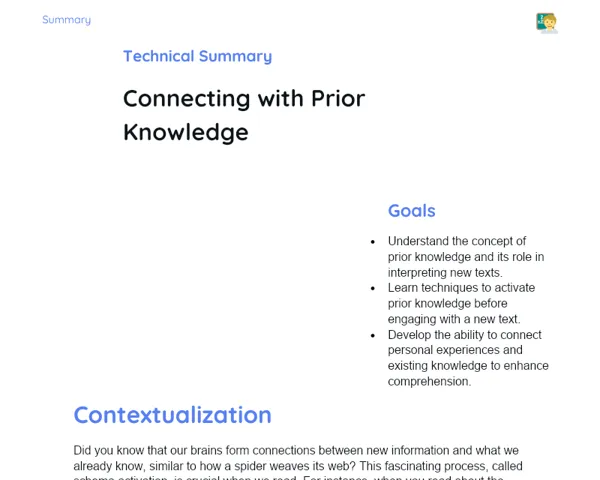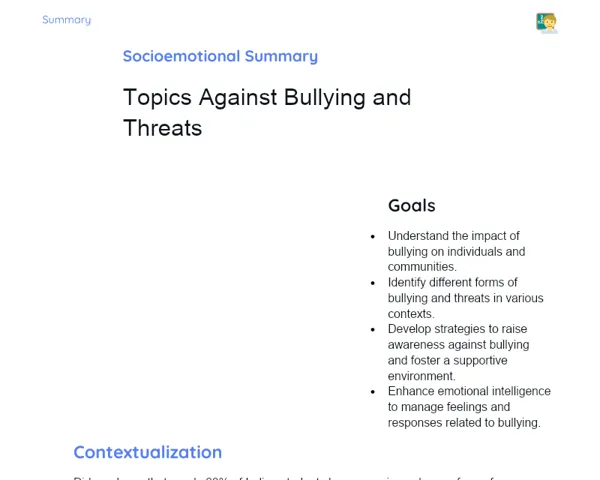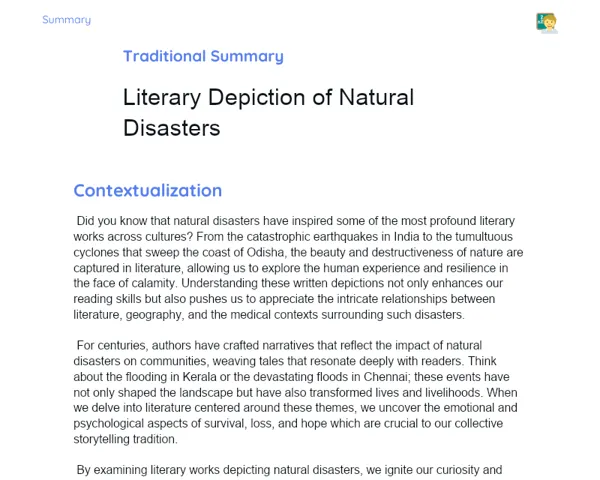Summary Tradisional | Verbs: Simple Past Regular and Irregular Verbs
Contextualization
The simple past tense is one of the essential verb forms in English, used to describe actions that happened and were completed in the past. It's important for day-to-day communication, whether you're casually chatting about your weekend or discussing historical incidents in a more formal setting. Mastering the simple past allows students to convey past events clearly, which is crucial for effective speaking and writing in English.
When forming the simple past, verbs fall into two categories: regular and irregular. Regular verbs follow a consistent rule by adding the suffix '-ed' to the base verb. For instance, 'walk' becomes 'walked'. In contrast, irregular verbs don't adhere to a set pattern and their past forms must be memorised, like 'go', which becomes 'went'. Understanding these distinctions is vital for using the simple past correctly, as well as for constructing affirmative, negative, and interrogative sentences.
To Remember!
Formation of the Simple Past for Regular Verbs
Regular verbs in the simple past are created by adding '-ed' to the base verb. This is a rule that most verbs in English follow. For example, 'walk' becomes 'walked', and 'play' turns into 'played'. It's worth noting that the pronunciation of '-ed' can differ based on the ending of the base verb and can sound like /t/, /d/, or /ɪd/.
There are also some spelling rules to keep in mind when adding '-ed'. For verbs ending in 'e', you just add 'd' (e.g., 'love' turns into 'loved'). For one-syllable verbs that end with a consonant-vowel-consonant (CVC) structure, you double the last consonant before adding '-ed' (e.g., 'stop' becomes 'stopped').
Moreover, for verbs that end with 'y' and have a consonant before it, you change 'y' to 'i' before adding '-ed' (e.g., 'study' turns into 'studied'). Grasping and applying these spelling rules is important for correctly forming the simple past of regular verbs.
-
Add '-ed' to the base verb.
-
Specific spelling rules: doubling consonants, changing 'y' to 'i'.
-
Variations in how '-ed' is pronounced.
Irregular Verbs in the Simple Past
Irregular verbs in the simple past don't follow a fixed rule for creating the past form, so their forms need to be memorised individually. Each irregular verb has its own unique simple past form that usually doesn't correlate with its present form. For example, 'go' becomes 'went', and 'see' turns into 'saw'.
Since there's no standardized rule, memorization and practice are crucial for mastering irregular verbs. One effective method is to compile lists of common irregular verbs and regularly practice their conjugation. Additionally, reading English texts and listening to conversations can help you get accustomed to these irregular forms in real-life situations.
It's important to remember that the base form of the verb is used after the auxiliary 'did' in negative and interrogative sentences, regardless of whether the verb is regular or irregular. For example, 'Did you go?' and 'Did you see?' are correctly structured questions in the simple past.
-
Do not adhere to a fixed rule.
-
Memorization and practice are crucial.
-
Use the base form after 'did'.
Using the Simple Past in Affirmative Sentences
To form affirmative sentences in the simple past, simply use the past form of the verb, whether it’s regular or irregular. In affirmative sentences, the subject is immediately followed by the past verb. For instance, 'She walked to school' and 'They saw a movie'.
This structure is straightforward and doesn’t require auxiliaries. Using the simple past to describe completed actions ensures clarity in communication. It's important to practice constructing affirmative sentences with various subjects and verbs to solidify this understanding.
Additionally, engaging with texts that utilise the simple past through reading and writing can aid in internalizing the structure and correct usage of regular and irregular verbs.
-
Direct use of the past verb form.
-
Does not require auxiliaries.
-
Practice with different subjects and verbs.
Using the Simple Past in Negative and Interrogative Sentences
To create negative sentences in the simple past, use the auxiliary 'did not' (or 'didn’t') followed by the verb in its base form. For example, 'She did not (didn't) walk to school' and 'They did not (didn't) see a movie'. The use of 'did' is important to indicate negation in the simple past.
To form questions in the simple past, the auxiliary 'did' is used as well, but the subject and auxiliary are inverted. For example, 'Did she walk to school?' and 'Did they see a movie?'. The interrogative structure in the simple past is vital for everyday communication.
Practicing how to transform affirmative sentences into negative and interrogative structures helps reinforce the understanding of these forms. Also, remember, in both cases, the main verb stays in its base form, and the auxiliary 'did' highlights the past tense.
-
Use of 'did not' (or 'didn’t') for negation.
-
Inversion of the subject and auxiliary 'did' for questions.
-
The main verb remains in its base form.
Key Terms
-
Simple Past: A verb tense that describes actions completed in the past.
-
Regular Verbs: Verbs that form the simple past by adding '-ed' to the base form.
-
Irregular Verbs: Verbs that do not follow a fixed rule to form the simple past.
-
Did Auxiliary: Used for making negative and interrogative sentences in the simple past.
-
Base Form: The original verb form without any conjugation.
Important Conclusions
In this lesson, we covered how to form the simple past for both regular and irregular verbs, a key element for effective communication regarding past events. We learned that regular verbs follow a consistent pattern by adding '-ed', while irregular verbs lack a fixed rule and require individual memorization. We also discussed constructing affirmative, negative, and interrogative sentences in the simple past, using 'did' for negations and questions.
Grasping these grammatical structures is essential for enhancing students' language skills, enabling them to relate past events effectively. Understanding the differences between regular and irregular verbs, along with accurately applying spelling and conjugation rules, greatly improves fluency and correctness in English communication.
Finally, continuous practice and exposure to the simple past in real contexts—like reading and listening to English texts—are vital for consolidating this knowledge. We encourage students to keep exploring and practising the use of the simple past to strengthen their language abilities.
Study Tips
-
Create lists of commonly used regular and irregular verbs and practice their conjugation in the simple past regularly.
-
Read materials and listen to English conversations that use the simple past to familiarise yourself with the structures and usage of these verbs.
-
Practice converting affirmative sentences into negative and interrogative forms to reinforce your grasp of grammatical rules.



